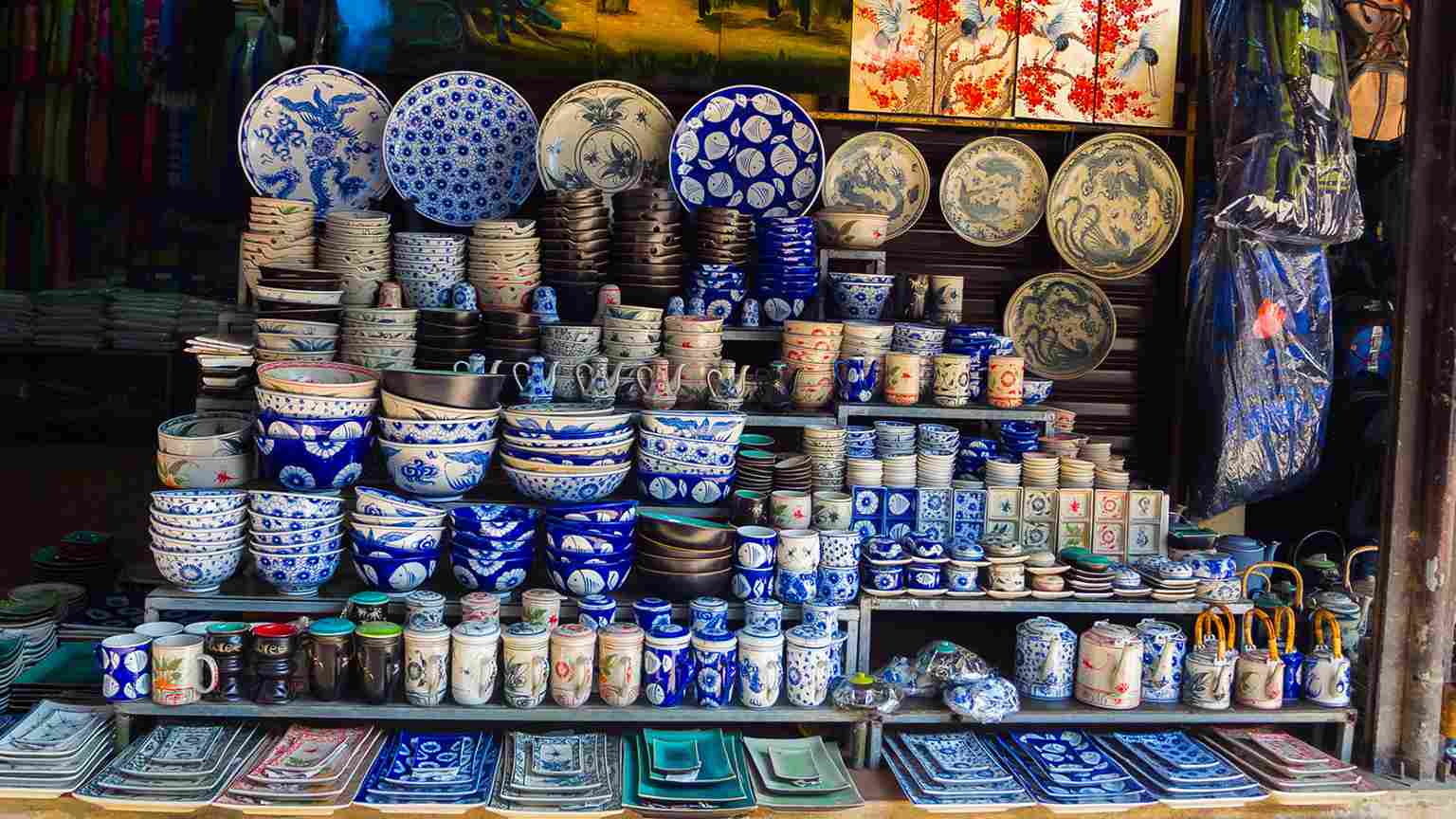News
Appreciate the Historical Significance of Bat Trang Ceramics
Bat Trang ceramics have long stood as a symbol of Vietnam’s rich cultural heritage and artistic craftsmanship. Rooted deeply in tradition, these ceramics are more than mere pottery; they are a testament to centuries of creativity, resilience, and innovation. The story of Bat Trang ceramics is intertwined with the socio-economic development of Vietnamese society and reflects the evolution of artistry through generations. Exploring Bat Trang ceramics opens a window into the past, revealing how a humble village transformed into a renowned center of ceramic production known far beyond its borders.
The Origins and Evolution of Bat Trang Ceramics

Understanding the historical roots of Bat Trang ceramics allows us to appreciate their significance fully. From ancient techniques to modern adaptations, this section delves into the journey of Bat Trang ceramics through time.
The origins of Bat Trang ceramics trace back over 700 years. Located on the banks of the Red River near Hanoi, Bat Trang village was blessed with abundant natural resources, including clay deposits ideal for pottery-making. This geographical advantage set the stage for the village to develop a thriving ceramic industry.
Bat Trang ceramics initially served practical purposes—creating utensils and household items for everyday use. However, as trade routes expanded and artistic demands grew, the ceramics evolved from simple functional wares to exquisite art pieces characterized by sophisticated designs and glazing techniques.
Early Beginnings: The Birthplace of Tradition
The inception of Bat Trang ceramics is entwined with local folklore and artisan lineage traditions. Potters passed down their craft orally and through apprenticeships, preserving unique methods like high-temperature firing and intricate hand-painting.
During the Ly and Tran dynasties (11th to 14th centuries), Bat Trang began gaining prominence when the royal court’s patronage elevated its status. Ceramics were not only utilitarian but also used in ceremonial contexts, reflecting cultural values and spiritual symbolism.
This early period shows how Bat Trang ceramics encapsulate both the practical needs and the aesthetic aspirations of Vietnamese society. Each pot or vase crafted carried the weight of ancestral knowledge and cultural identity, making them precious artifacts of history.
Growth Through Trade and Influence
The expansion of trade across Southeast Asia and beyond played a crucial role in shaping Bat Trang ceramics’ style and reach. Merchants introduced new shapes, glazes, and motifs influenced by Chinese, Korean, and Japanese pottery traditions.
This cross-cultural exchange spurred innovation. Bat Trang artisans adapted foreign techniques like celadon glazing while retaining distinct Vietnamese motifs such as lotus flowers, dragons, and folk patterns. These hybrid designs enriched the artistic vocabulary of Bat Trang ceramics, enabling them to captivate a broader audience.
Moreover, Bat Trang ceramics became a significant export commodity during the 15th and 16th centuries. Archaeological finds reveal Bat Trang pottery fragments scattered along ancient maritime trade routes, underscoring their global appeal.
Modern Developments and Preservation Efforts
With industrialization and modernization, traditional Bat Trang ceramic-making faced challenges, including competition from mass-produced goods and shifts in consumer preferences. Nevertheless, efforts to preserve and revive this heritage have intensified.
Today, Bat Trang ceramics balance tradition with contemporary trends. Many artisans continue to employ age-old techniques while experimenting with new forms and themes, ensuring that the craft remains relevant.
Government initiatives and cultural programs promote Bat Trang as a cultural tourism hub, encouraging visitors to witness pottery-making firsthand. Such endeavors safeguard this intangible heritage, fostering appreciation among younger generations.
The historical evolution of Bat Trang ceramics exemplifies resilience and adaptability, highlighting how cultural practices endure amidst changing times while maintaining their essence.
Artistic Characteristics and Techniques of Bat Trang Ceramics

Bat Trang ceramics are distinguished by a combination of technical mastery and artistic expression. This segment explores the defining features and creative processes that make Bat Trang products stand out globally.
When discussing Bat Trang ceramics, it is essential to understand the materials, shapes, decorative elements, and firing methods that contribute to their uniqueness.
Material Selection: The Heart of Quality
At the core of Bat Trang ceramics lies the exceptional quality of local clay. The high plasticity and fine texture of this clay allow artisans to mold delicate yet durable objects.
Clay preparation involves meticulous refinement to remove impurities, ensuring the final product’s strength and smoothness. This initial step dictates the success of subsequent operations such as shaping and glazing.
The reverence for raw material quality reflects a deep connection between artisans and nature. Bat Trang potters view clay not merely as a medium but as a living substance imbued with potential, which they coax into shape through skilled hands.
Shaping Methods: From Wheel-Throwing to Handcrafting
Bat Trang potters employ various shaping techniques, including traditional wheel-throwing, coiling, and molding. The potter’s wheel, symbolic of timeless craft, enables the creation of symmetrical vessels ranging from bowls to large jars.
Hand-shaping techniques allow for more ornate or asymmetrical forms, often seen in figurines and decorative items. This flexibility showcases the artisans’ dexterity and creative freedom.
Each shaping method demands patience and precision, as any error can compromise the piece’s integrity. The process itself becomes a meditation on balance, form, and function.
Glazing and Decoration: The Signature Aesthetics
The glazing of Bat Trang ceramics is renowned for its vibrant colors and glossy finish. Traditional glazes include white, celadon green, brown, and blue, each requiring precise chemical formulations and firing conditions.
Decoration often incorporates hand-painted motifs inspired by nature, mythology, and daily life. Techniques such as underglaze painting, incising, and relief carving add depth and texture.
These decorative choices convey cultural narratives and artistic philosophies. For instance, lotus flowers symbolize purity, while dragons represent power and prosperity.
Firing Techniques: Crafting Durability and Beauty
Firing is a critical phase where raw clay transforms into hardened ceramic. Bat Trang kilns reach temperatures exceeding 1200 degrees Celsius, demanding expert control to avoid cracking or discoloration.
Traditional wood-fired kilns impart distinctive characteristics such as smoky hues and uneven glaze effects, enhancing the pieces’ individuality.
Contemporary artisans sometimes use electric kilns for consistency, especially in mass production. However, many still prefer traditional firing methods for their authenticity and aesthetic charm.
The interplay of material, technique, and artistic vision culminates in Bat Trang ceramics’ iconic appearance and enduring quality.
Cultural and Societal Impact of Bat Trang Ceramics

Beyond their aesthetic appeal, Bat Trang ceramics hold profound cultural and societal meanings. They embody Vietnamese identity and social values while influencing community life and economy.
Examining the cultural context enriches our understanding of why Bat Trang ceramics matter beyond their physical form.
Symbolism and Ritual Use in Vietnamese Culture
Ceramics from Bat Trang serve important functions in religious and social rituals. Items such as incense burners, altar vases, and ceremonial bowls play central roles in honoring ancestors and deities.
The design motifs carry symbolic messages embedded within Vietnamese cosmology and folklore. For example, phoenix imagery signifies rebirth and renewal, aligning pottery with spiritual beliefs.
This integration of ceramics into ritual life underscores their sacred dimension. They act as conduits between the material world and spiritual realms, facilitating cultural continuity.
Economic Role in Rural Communities
Bat Trang ceramics have historically been integral to the village’s economy. The craft provided livelihoods for generations, supporting artisans, traders, and related industries.
The cottage industry model fostered communal collaboration, where families specialized in different production stages. This collective enterprise strengthened social ties and preserved knowledge transmission.
In recent decades, ceramics remain a vital economic driver through exports and tourism. Local markets and workshops attract visitors eager to purchase authentic handmade products.
Promoting sustainable practices and fair trade ensures that economic benefits fairly distribute among producers, helping safeguard the community’s well-being.
Influence on Contemporary Vietnamese Art and Design
The legacy of Bat Trang ceramics continues to inspire modern artists and designers. Creative reinterpretations of traditional forms integrate with contemporary aesthetics, producing innovative artworks and home decor.
Art schools and cultural institutions incorporate Bat Trang techniques into curricula, nurturing new talent and expanding the craft’s horizons.
Collaborations between artisans and designers introduce ceramics into fashion, architecture, and multimedia art, broadening their cultural relevance.
This dynamic interplay between tradition and modernity reinforces Bat Trang ceramics as living culture, evolving alongside society while retaining historical roots.
Global Recognition and Market Dynamics of Bat Trang Ceramics
The outstanding qualities of Bat Trang ceramics have garnered international acclaim, positioning them as prestigious collectibles and cultural ambassadors.
Exploring their global presence reveals how they navigate market forces, branding strategies, and cultural diplomacy.
International Exhibitions and Awards
Bat Trang ceramics have featured prominently in exhibitions worldwide, showcasing Vietnam’s artisanal heritage on global platforms.
Recognition through awards highlights technical excellence and artistic merit, elevating the reputation of individual artisans and the village collectively.
Such exposure promotes cultural pride and stimulates demand from foreign collectors and enthusiasts.
Export Markets and Consumer Preferences
Export activities extend Bat Trang ceramics to diverse markets, including Asia, Europe, and North America. Consumer preferences vary from classic styles to bespoke art pieces, influencing production focus.
Understanding market trends helps artisans tailor their offerings while maintaining authenticity. For instance, eco-conscious buyers appreciate natural materials and sustainable methods used in Bat Trang pottery.
Balancing mass production with handmade quality remains a challenge but offers opportunities for differentiation and niche marketing.
Challenges and Opportunities in the Global Economy
Competition from cheaper imports and synthetic alternatives poses risks to traditional Bat Trang ceramics. Intellectual property protection and quality certification become vital tools for safeguarding artisan interests.
Conversely, digital technology opens new avenues for marketing and direct sales, connecting artisans with global customers.
Cultural tourism linked to Bat Trang enhances economic sustainability by combining education, experience, and commerce.
Efforts to establish Bat Trang as a trademarked brand underscore the importance of preserving heritage while adapting to international business environments.
| Aspect | Description | Impact |
|---|---|---|
| Raw Material | High-quality local clay | Superior durability and texture |
| Production Techniques | Wheel-throwing, hand-shaping, traditional firing | Distinctive craftsmanship and aesthetics |
| Cultural Significance | Ritual use, symbolic motifs | Deep-rooted cultural identity |
| Economic Importance | Cottage industry, export market | Community livelihood and growth |
| Global Presence | Exhibitions, export, cultural tourism | International recognition and demand |
| Challenges | Competition, modernization pressure | Need for innovation and preservation |
Conclusion
Appreciating the historical significance of Bat Trang ceramics involves acknowledging their multifaceted essence—as artistic masterpieces, cultural symbols, economic pillars, and global treasures. Rooted in centuries-old traditions, these ceramics narrate stories of Vietnamese heritage, craftsmanship, and resilience. Their evolution reflects a delicate balance between preserving age-old techniques and embracing modern influences, ensuring their continuous relevance. As Bat Trang ceramics adorn altars, homes, and galleries worldwide, they invite us to cherish not only their beauty but also the rich human spirit that shaped them across generations.
